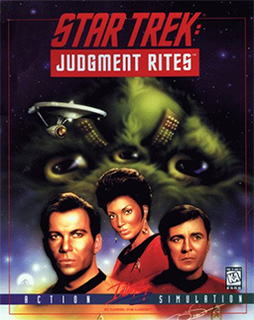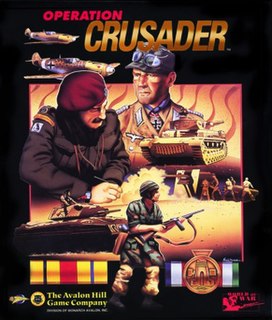Shovelware is a term for software bundles noted more for the quantity of what is included rather than for the quality or usefulness.

The Perfect General is a computer wargame published in 1991 by Quantum Quality Productions.

Panzer General is a 1994 computer wargame developed and published by Strategic Simulations Inc. (SSI). It simulates conflict during World War II. The designers of Panzer General were heavily influenced by the Japanese wargame series Daisenryaku.

Pokémon Stadium 2 is a strategy video game developed by Nintendo EAD and published by Nintendo for the Nintendo 64. It features all 251 Pokémon from the first and second generations of the franchise. It was released in Japan on December 14, 2000, in North America on March 26, 2001, and in Europe on October 10, 2001. In Western regions it was titled Pokémon Stadium 2, as it was the second Stadium game to be released outside Japan, in which it was the third game in the series. It supports Dolby Surround sound.
The fifth-generation era refers to computer and video games, video game consoles, and handheld gaming consoles dating from approximately October 4, 1993 to March 23, 2006. For home consoles, the best-selling console was the Sony PlayStation, followed by the Nintendo 64, and then the Sega Saturn. The PlayStation also had a redesigned version, the PSone, which was launched on July 7, 2000.

Star Trek: Judgment Rites is a computer game first produced by Interplay Productions in 1993, featuring the original cast of the classic Star Trek in a series of new adventures, including one featuring Trelane, the omnipotent child from the original episode "The Squire of Gothos". Judgment Rites uses the same MS-DOS gaming engine as the earlier Star Trek: 25th Anniversary; however, it had sharper graphics and sound, particularly with the CD-ROM edition. All of the initial cast members provided voices for their characters on the game.

Crash Bandicoot 2: Cortex Strikes Back is a 1997 platform video game developed by Naughty Dog and published by Sony Computer Entertainment for the PlayStation. It is a sequel to Crash Bandicoot (1996), and is part of the Crash Bandicoot series.

American Laser Games was a company based in Albuquerque, New Mexico that created numerous light gun laserdisc video games featuring live action full motion video. The company was founded in the late 1980s by Robert Grebe, who had originally created a system to train police officers under the company name ICAT and later adapted the technology for arcade games. Its first hit game was Mad Dog McCree, a light gun shooter set in the American Old West. By mid-1995 they were recognized as the leading company in the medium of laserdisc-based arcade games. Almost all arcade games released by the company were light gun shooters and a number of them also had an Old West theme.

The PocketStation is a Memory Card peripheral by Sony Computer Entertainment for the PlayStation home video game console. Categorized by Sony as a combination of a Memory Card and a miniature personal digital assistant, the device features a monochrome liquid crystal display (LCD), infrared communication capability, a real-time clock, built-in flash memory, and sound capability. To use the device's memory card functionality, it must be connected to a PlayStation through a memory card slot. It was released exclusively in Japan on January 23, 1999.

Dune II: The Building of a Dynasty is a real-time strategy Dune video game developed by Westwood Studios and released by Virgin Games in December 1992. It is based upon David Lynch's 1984 movie Dune, an adaptation of Frank Herbert's science fiction novel of the same name.
The Grandest Fleet is a turn-based naval tactics game that was released by Quantum Quality Productions in 1993.
Mark Lewis Baldwin is a computer game designer, most noted for his work on The Perfect General and Empire Deluxe. He has three games on Computer Gaming World's list of the best games of all time.

Battles in Time was a PC video game and was the only product co-developed by Quantum Quality Productions and American Laser Games. The game was a time travel-based strategy game.
Merchant Prince is a turn-based 4X strategy video game franchise set in the Republic of Venice during the Renaissance. The first Merchant Prince was published in 1994; Machiavelli the Prince in 1995; and Merchant Prince II in 2001. All three were developed by Holistic Design (HDI) but had separate publishers. The first two use MS-DOS; the third Windows. All three support up to four players and differ chiefly in their graphics and user interface.

The Crystal Key is a 1999 graphic adventure video game developed by Earthlight Productions and published by DreamCatcher Interactive. A work of science fiction, it casts the player as an interstellar explorer on a quest to save Earth from Ozgar, a malevolent alien conqueror. The player uses portals to traverse multiple planets, including desert and jungle worlds, while collecting items and solving puzzles. The Crystal Key was conceived by John and Jennifer Matheson in the mid-1990s, and it underwent a five-year creation process hampered by problems with its technology. It was signed by DreamCatcher as part of the publisher's strategic push into the adventure game genre.

Harpoon is a computer wargame published by Three-Sixty Pacific in 1989 for MS-DOS. This was the first game in the Harpoon series. It was ported to the Amiga and Macintosh.
The Red Crystal: The Seven Secrets of Life is a 1994 role-playing video game developed and published by Quantum Quality Productions.

Operation Crusader is a 1994 computer wargame developed by Atomic Games and published by Avalon Hill.

Solitaire's Journey is a 1992 video game by Quantum Quality Productions for Amiga and DOS.

Battles of Destiny is a 1992 strategy video game developed by Holistic Design and published by Quantum Quality Productions.













